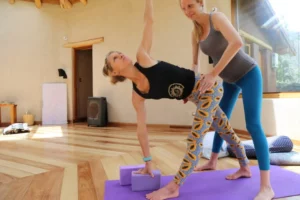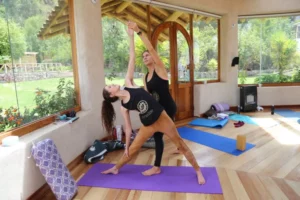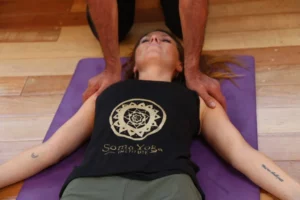Updated 10/5/24
Teachers of many yoga asana classes integrate hands-on adjustments and assists in their public classes. Adjustments come in many forms. From a simple light directional touch to an adjustment that is more active, approaching the realm of bodywork. This usually depends on the style of yoga and the instructor’s background knowledge.
The ultimate intention of a hands-on adjustment is to assist a yogi to embody an aligned expression of a posture. This posture should be one they cannot access on their own.
Assists are thus a form of physical scaffolding which helps the yogi to build strength, joint integrity and confidence. Ultimately they increase the student’s proprioceptive intuition. Ideally this is so so that they learn to find their optimal alignment even when the teacher is not around.

The debate about hands-on adjustments
The topic of yoga adjustments is one of debate within the yoga community. Staunch supporters of hands-on adjustments insist that this ability can distinguish a practiced instructor and deepen a students practice. Others cite the possibility for injuring a student as evidence that adjustments have no place in asana classes. But the topic up for debate is far more nuanced than simply saying “yes” or “no” to physical adjustments. Practicing hands-on adjustments in a positive and healing way demands instructor sensitivity to a student’s emotional and mental needs. As well as an understanding of a trauma-informed approach. Being sensitive to traumatic stress requires the consideration that any student may possibly experience a trigger from a hands on touch. This would create a traumatic-stress response within the student’s sympathetic nervous system. Such an action can re-traumatize a student and harm, rather than heal.
Thus it is vital that an teacher learn to identify those students. They must know who prefers to be left alone, those who prefers verbal adjustment, and those who consent to and welcome physical touch in their practice.
Science behind Yoga Adjustments
A survey conducted by David Keil of yogaanatomy.com (1) reveals that 97% of respondents reported having received a hands-on adjustment. Furthermore, 71.9% found these adjustments to be “very helpful.” This practitioner survey also revealed that about 53.9% of respondents who used yoga for healing from pain or injury indicated that hands-on adjustments had contributed to this healing.

So, how are we as teachers to know what is best for our students?
David Keil’s (1) study was conducted on primarily seasoned practitioners (those with 4+ years of consistent time spent on the mat). They also practice between 60-90 minutes per session at the studio or in-home practice. Most were female and between the ages of 31 and 55 years old. Practitioners reported engaging in one or more of a variety of styles. Additionally, 60% practicing Ashtanga, and another 37.9% practicing Vinyasa/Power/Flow yoga. Hatha and Yin/Restorative followed closely at 34% and 30.5% respectively, and 15.2% practiced Iyengar. 7.1% reported practicing multiple styles.
Of those who reported incurring a physical injury while practicing yoga, 22.2 % indicated they were receiving a physical adjustment when the injury occurred. Another 4.6 % indicated the injury occurred while being given a verbal adjustment. Ultimately, the survey revealed that approximately 11% of those who have ever received a hands-on adjustment have also been injured. 7% of respondents reported that their experience with adjustments has contributed to both states of healing and injury.
Given these data, the question remains: are adjustments contributing more to experiences of injury or healing?
Communication about Yoga Adjustments
To further compound the question of adjustments in yoga instruction, there is the issue of whether or not an instructor conducts adjustments with open lines of clear communication with a student. Soma Yoga Institute conducts informal surveys with their yoga teacher trainees who indicate that they, at some point, experienced an adjustment that felt unsafe or was injurious (1). Of this group 97% report back that they had not let the instructor know the assist felt unsafe or caused harm. Reasons for this range from being anxious or embarrassed to criticize an instructor or disrupt class, to not wanting to make the teacher feel bad, to defaulting to the knowledge of the instructor instead of trusting their own inner wisdom.
This feedback then helps us as teachers, and as a yoga community to critically examine the way we practice adjustments. As well as to refine the questions we are asking ourselves and our students. If hands-on assists and adjustments are contributing to both healing and injury, how then do we more effectively use adjustments in a way that contributes to the healing process?
AND how do we use adjustments in a way which reduces the chance for negative impact and injury?
We further learned from David Keli’s study that injury during adjustments occurred in three major categories. These include poses that involve reaching end of range of motion for a joint, poses that put pressure into a joint or muscle attachment that is anatomically tenuous, and poses that involve balance and/or momentum, or where there is a potential to fall. (1)

In Conclusion
Because the personalized history of each student is complex and each brings to the mat a unique set of past life experiences and postural habits, the hands-on adjustments we provide must be sensitive, individualized, and based on sound anatomical principles. Rather than offering assists that incite ambition for the deepest and biggest form of a pose or assisting through a “one size fits all” approach, teachers including assists in their instruction have a responsibility to use a framework of healthy biomechanics and conscious listening. When skillful instructional techniques are used students are able to re-train movement patterns to support long term joint health, maximize their movement of breath and prana, and increase their overall wellbeing. In this way, we can increase the potential for healing to occur.
If you are interested in developing the knowledge and skills necessary to give hands-on adjustments and assists in your yoga instruction with competence, safety, and confidence please join Yoga Therapist, Liz Heffernan and senior teacher, Peggy Profant for their online course. Complete at your own pace from the comfort of your home. https://somayogainstitute.com/course-assist
1. David Keil. Injuries In Yoga Adjustments: What Are Practitioners. https://www.yoganatomy.com/injuries-in-yoga-adjustments/